
This is the Page,
Historical Sketch
Edited 29 May 2016
Home
Bakery Benchmarks
Our Breads Nos pains
Bread Images
About Us
Our Equipment
Site Map
Sources - Digital
Sources - Printed
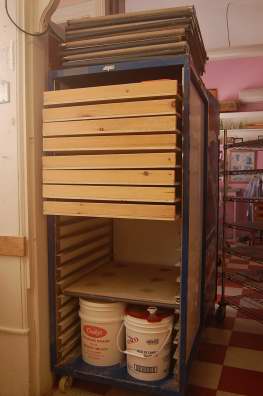
Bôite Parisienne: Box for final proof of breads, especially baguettes, superceded in 2006 by the 'planche carrier'. Photo by Richard Rice, 25 April 2007
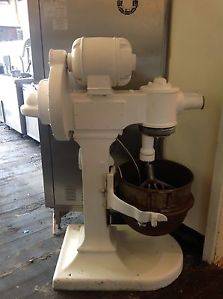
This is a photo of the type of mixer with which we began in 1988, a 60 quart 'vintage' Hobart. This we replaced with the latest model in the fall of 1990, now called 'Old Style', pictured below.
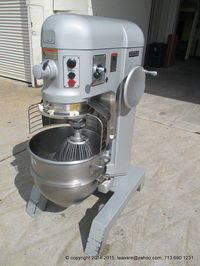
Noted for their planetary action, the 60 Qt Hobarts have been the main mixer/kneader machines in our bakery, for medium to large batters, and small to medium bread doughs (5-18 kg of flour).
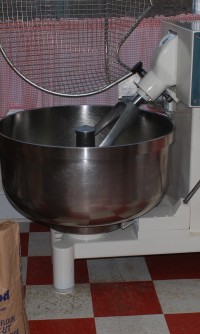
Phébus fork kneader (pétrin)
40kg flour capacity, acquired in 2012, for doughs of 20-40 kg of flour.
Historical Sketch
Edited 29 May 2016
Home
Bakery Benchmarks
Our Breads Nos pains
Bread Images
About Us
Our Equipment
Site Map
Sources - Digital
Sources - Printed
Bôite Parisienne: Box for final proof of breads, especially baguettes, superceded in 2006 by the 'planche carrier'. Photo by Richard Rice, 25 April 2007
This is a photo of the type of mixer with which we began in 1988, a 60 quart 'vintage' Hobart. This we replaced with the latest model in the fall of 1990, now called 'Old Style', pictured below.
Noted for their planetary action, the 60 Qt Hobarts have been the main mixer/kneader machines in our bakery, for medium to large batters, and small to medium bread doughs (5-18 kg of flour).
Phébus fork kneader (pétrin)
40kg flour capacity, acquired in 2012, for doughs of 20-40 kg of flour.
BOULANGERIE
NORTH HEAD BAKERY
Hearth breads, Craft and Community, since 1988
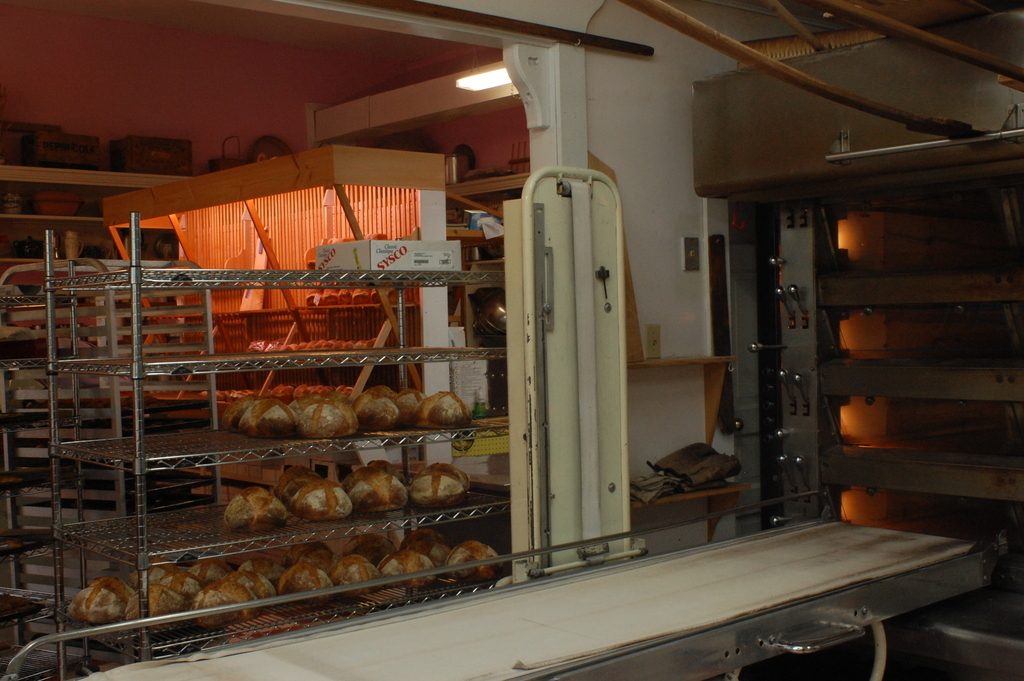
From away, Martha and I hung out the shingle, Richard's Bread, at the Grand Manan Whale and Seabird Research Station in the late fall of 1988, in the back kitchen, opposite what is now the ferry car park in North Head. This was a trial, minimalist bakery, with a pre-1956 mixer, a pizza oven that wobbled like a moose, and a maple-topped worktable, which, after 9 am, served as sales counter. For cash register, we used an old tobacco tin, maybe it was a coffee container. Martha brought nearly fifteen years of cooking experience to the task, having put in many years in at the Compass Rose, but more recently as cuisinière à la passe at "l'Express" in Montreal and cook at the "Pilsen" in North Hatley, Qc. Richard's work history was varied, from car salesman and fledgling financial analyst through teacher to university instructor in central Canada, turning in 1986 to the world of manual labour, beginning as apprentice baker at the Montreal bakery, "Aux bons croissants", and then working there on and off as baker, for several years.
Our idea in 1988 was to make the best bread we knew how, and, in return we hoped, make a living. This was, of course, the social relation of the artisan. More than 20 years later, we continue with the same principle, although there have been many twists and turns along the way: the move to the current location and name in 1990, newer ovens, mixers, proofing cabinets, refrigeration devices, and many other productive utensils and smallwares, continual upgrading of ingredients, constant refining of recipes and techniques, study in the USA (National Baking Center) and in France (Institut National de la Boulangerie), and several forays into wholesaling, especially from 1996 to 2001 by selling through a series of retail outlets in southeastern New Brunswick, which saw our truck doing up to 1400 km a week, on the 'Mainland'.
The origins of baking, domestic and artisanal, on Grand Manan are largely hidden in the mists of immemorial time. A reasonable guess would set the beginning with the original white, Loyalist settlement in the mid 1780's. There was some cultivation of wheat, as there was a grist mill (on the creek up Cedar Street, just below the juncture with Dock Road) and what appears to have been a top stone, perhaps from that mill, survives, outside the Grand Manan Museum (photograph on ''Bakery Benchmarks''). It is probable that baking was done in household brick ovens, of the beehive variety (The remains of one can still be detected on Ross Island, at the top of the field where the Loyalists first landed). The notion that there was likely such a baking tradition on the Island appears to have been swept away in what we might loosely term the period of industrializastion on the Island, attendant upon the apparently widespread adoption of wage labour in the third quarter of the 19th century via the general move into smoked herring, capital-intensive assault on the Island's forests by the establishment of the steam sawmill at Dark Harbour, the erection of canning factories, and the establishment of regular, steam ferry service to the Mainland. The last mentioned was coincident with the development of industrial or roller milled flour and commercial yeast on the Mainland, to say nothing of the pervasive adoption of the iron stove for cookery, heating and baking. In this latter develpment, we can readily surmise the appearance of the square loaf, encased in moulds ("tins"), for proofing and baking - the shape which in another generation or so was to reach a commercial apotheosis with ''Wonderbread''.
Domestic baking of tinned bread was a strong custom on the Island, as we got underway, especially evident in the custom of 'Saturday beans and [pan]rolls'. And it was not invariably the woman of the household who was baker. However, there was precedent for a commercial bakery, that of Peter Reynolds who somehow washed up on the Island and set up his bakery across from Poodle Alley, perhaps in the 1920's, with a Hubbard ("Hubbard Ovens Make Bakers Happy"*) horizontal, electric mixer of about 50 pounds of flour capacity and what must have been a coal fired metal oven, of a comparable capacity. One of our customers fondly remembered the apple turnovers he got there as a boy. In later years, said a grandson, the bakery latterly operated as a carrier of mainland factory bread, but at the end, possibly in the early 1960's, solely as a bread distributor. Since then, two generations of men have continued to meet the ferry for bread and distribute it to Island retailers; the son of the second continues to this day in the same function. A few years before us, a mainly wholesale bakery was set up by a fishing family in Seal Cove under a provincial economic initiative program and operated for about five years. And since we started, two more small, wholesale bakeries have come and gone, and there has been an in-store bakery for several years in the Island "Save Easy" supermarket, part of the Weston chain.
When we first contemplated setting up a bakery here, there were many small, general stores up and down the Island, most without exterior signs outside announcing their activities, just as there was a similar though lesser host of gas stations. Now there is effectively one significant retailer of both food and gas, the aforementioned Save Easy. In setting out we wished to target industrial bread. In an ironic twist, it often turned out that our bread appealed to people who made their own, but found it easier/preferable to buy our's. A second irony is that the longer we have made bread the more antique have been the recipes and procedures we have employed: linen cloths for proofing, wooden bowls and peels, and marble counters, notably; but also steep reductions of yeast quantities, incorporation of French sea salt in diminished quantity, employment of pre-ferments and long fermentations, major reduction in mixing intensities and times. Probably the major irony, at least for the baker, is that despite the fundamental cheapness, goodness and democratic nature of our bread, its appeal has frequently been felt more by summer residents and others from away. In short, to a degree larger than wished, we have found ourselves in a niche market. In a way what we make is ordinary, pre-industrial bread. Just like woollen garments which have become upscale products, so our bread tends to be eaten elitely. Not at all our intention.
These socio-economic trends which we have lived as an artisanal bakery are hardly isolated to Grand Manan. That the concentration of industrial food consumption has gone on apace here and on the Mainland is a banal observation, but none the less forceful for that. That we have found a niche in this system is perhaps not so similar as the Mainland experience, at least on the Anglo side of the national ledger; but it is broadly reflective of changes in traditonal French baking in France.**
Hearth breads, Craft and Community, since 1988
Historical Sketch
From away, Martha and I hung out the shingle, Richard's Bread, at the Grand Manan Whale and Seabird Research Station in the late fall of 1988, in the back kitchen, opposite what is now the ferry car park in North Head. This was a trial, minimalist bakery, with a pre-1956 mixer, a pizza oven that wobbled like a moose, and a maple-topped worktable, which, after 9 am, served as sales counter. For cash register, we used an old tobacco tin, maybe it was a coffee container. Martha brought nearly fifteen years of cooking experience to the task, having put in many years in at the Compass Rose, but more recently as cuisinière à la passe at "l'Express" in Montreal and cook at the "Pilsen" in North Hatley, Qc. Richard's work history was varied, from car salesman and fledgling financial analyst through teacher to university instructor in central Canada, turning in 1986 to the world of manual labour, beginning as apprentice baker at the Montreal bakery, "Aux bons croissants", and then working there on and off as baker, for several years.
Our idea in 1988 was to make the best bread we knew how, and, in return we hoped, make a living. This was, of course, the social relation of the artisan. More than 20 years later, we continue with the same principle, although there have been many twists and turns along the way: the move to the current location and name in 1990, newer ovens, mixers, proofing cabinets, refrigeration devices, and many other productive utensils and smallwares, continual upgrading of ingredients, constant refining of recipes and techniques, study in the USA (National Baking Center) and in France (Institut National de la Boulangerie), and several forays into wholesaling, especially from 1996 to 2001 by selling through a series of retail outlets in southeastern New Brunswick, which saw our truck doing up to 1400 km a week, on the 'Mainland'.
The origins of baking, domestic and artisanal, on Grand Manan are largely hidden in the mists of immemorial time. A reasonable guess would set the beginning with the original white, Loyalist settlement in the mid 1780's. There was some cultivation of wheat, as there was a grist mill (on the creek up Cedar Street, just below the juncture with Dock Road) and what appears to have been a top stone, perhaps from that mill, survives, outside the Grand Manan Museum (photograph on ''Bakery Benchmarks''). It is probable that baking was done in household brick ovens, of the beehive variety (The remains of one can still be detected on Ross Island, at the top of the field where the Loyalists first landed). The notion that there was likely such a baking tradition on the Island appears to have been swept away in what we might loosely term the period of industrializastion on the Island, attendant upon the apparently widespread adoption of wage labour in the third quarter of the 19th century via the general move into smoked herring, capital-intensive assault on the Island's forests by the establishment of the steam sawmill at Dark Harbour, the erection of canning factories, and the establishment of regular, steam ferry service to the Mainland. The last mentioned was coincident with the development of industrial or roller milled flour and commercial yeast on the Mainland, to say nothing of the pervasive adoption of the iron stove for cookery, heating and baking. In this latter develpment, we can readily surmise the appearance of the square loaf, encased in moulds ("tins"), for proofing and baking - the shape which in another generation or so was to reach a commercial apotheosis with ''Wonderbread''.
Domestic baking of tinned bread was a strong custom on the Island, as we got underway, especially evident in the custom of 'Saturday beans and [pan]rolls'. And it was not invariably the woman of the household who was baker. However, there was precedent for a commercial bakery, that of Peter Reynolds who somehow washed up on the Island and set up his bakery across from Poodle Alley, perhaps in the 1920's, with a Hubbard ("Hubbard Ovens Make Bakers Happy"*) horizontal, electric mixer of about 50 pounds of flour capacity and what must have been a coal fired metal oven, of a comparable capacity. One of our customers fondly remembered the apple turnovers he got there as a boy. In later years, said a grandson, the bakery latterly operated as a carrier of mainland factory bread, but at the end, possibly in the early 1960's, solely as a bread distributor. Since then, two generations of men have continued to meet the ferry for bread and distribute it to Island retailers; the son of the second continues to this day in the same function. A few years before us, a mainly wholesale bakery was set up by a fishing family in Seal Cove under a provincial economic initiative program and operated for about five years. And since we started, two more small, wholesale bakeries have come and gone, and there has been an in-store bakery for several years in the Island "Save Easy" supermarket, part of the Weston chain.
When we first contemplated setting up a bakery here, there were many small, general stores up and down the Island, most without exterior signs outside announcing their activities, just as there was a similar though lesser host of gas stations. Now there is effectively one significant retailer of both food and gas, the aforementioned Save Easy. In setting out we wished to target industrial bread. In an ironic twist, it often turned out that our bread appealed to people who made their own, but found it easier/preferable to buy our's. A second irony is that the longer we have made bread the more antique have been the recipes and procedures we have employed: linen cloths for proofing, wooden bowls and peels, and marble counters, notably; but also steep reductions of yeast quantities, incorporation of French sea salt in diminished quantity, employment of pre-ferments and long fermentations, major reduction in mixing intensities and times. Probably the major irony, at least for the baker, is that despite the fundamental cheapness, goodness and democratic nature of our bread, its appeal has frequently been felt more by summer residents and others from away. In short, to a degree larger than wished, we have found ourselves in a niche market. In a way what we make is ordinary, pre-industrial bread. Just like woollen garments which have become upscale products, so our bread tends to be eaten elitely. Not at all our intention.
These socio-economic trends which we have lived as an artisanal bakery are hardly isolated to Grand Manan. That the concentration of industrial food consumption has gone on apace here and on the Mainland is a banal observation, but none the less forceful for that. That we have found a niche in this system is perhaps not so similar as the Mainland experience, at least on the Anglo side of the national ledger; but it is broadly reflective of changes in traditonal French baking in France.**
* The said mixer with
said
inscription resides in the bakery basement, where it found haven from
its trip to 'the dump', about fifteen years ago.
**Steven L Kaplan, Le retour du bon pain, 2002. One of the main themes or arguments of this long and forceful book is that the return of good bread was not only a deliberate strategy on the part of several key actors and bakers, but also the road to survival of French bread and breadmakers.
**Steven L Kaplan, Le retour du bon pain, 2002. One of the main themes or arguments of this long and forceful book is that the return of good bread was not only a deliberate strategy on the part of several key actors and bakers, but also the road to survival of French bread and breadmakers.
© 2016 North Head
Bakery, 199 Route 776, Grand Manan, NB, E5G 1A4 506-662-8862